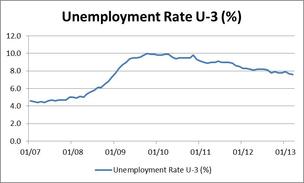
Official Unemployment Rate (U-3). In my opinion, focusing on the official employment rate as issued by the Bureau of Labor Services (BLS) provides an incomplete (and potentially misleading) picture of the unemployment situation. This headline rate is known as the U-3 unemployment rate, and focuses on people out of work that have actively sought work in the past four weeks. According to the BLS: "Persons are classified as unemployed if they do not have a job, have actively looked for work in the prior 4 weeks, and are currently available for work." It ignores people that have stopped looking for work or people that are working part-time but who want to work full-time. The chart to the right shows the U-3 unemployment rate from 2007 to present, with the peak of 10% unemployment during the recent recession (data from the BLS website).
U-6 Unemployment Rate. The U-6 unemployment rate is based on the U-3 unemployment rate and adds people who are "marginally attached workers" and part-time workers who want to work full-time but cannot due to economic reasons. This broader measure of unemployment captures underemployed workers, but still excludes people who have given up on looking for work and so are not considered to be part of the workforce. This could be people who have retired or have simply given up looking for work because they couldn't find a job. This U-6 measure of unemployment was 13.8% in March 2013, down from a peak of 17.1% in October 2009. This data is not easy to find on the BLS website, but here's the link: http://www.bls.gov/webapps/legacy/cpsatab15.htm
Employment. The BLS also publishes employment data, with the non-farm payroll employment data being the most commonly used. For example, the recent headlines that the economy added 88,000 jobs refers to non-farm payrolls (here's a link to the recent BLS announcement: http://www.bls.gov/news.release/empsit.nr0.htm). According to preliminary numbers from the BLS, non-farm payroll employment reached 135,195,000 in March 2013, up from a low of 129,320,000 in February 2010. Many economists estimate that it takes a monthly increase in employment of at least 150,000 for the workforce to keep up with population growth.
Labor Force Participation Rate. The labor force participation rate measures the percentage of the labor force that is working or actively looking for work. The labor force in the US is defined by the BLS as people aged 16 and over. According to the BLS, the Labor Force Participation rate fell to 63.3% in March 2013, down from a high of 67.3 in early 2000. The Labor Force Participation Rate has trended down since 2000, but the pace of decline picked up in the latest recession. There's a good article on the blog Calculated Risk discussing the Labor Force Participation Rate - here's the link: http://www.calculatedriskblog.com/2013/04/labor-force-participation-rate-update.html?. Here's a good discussion on Seeking Alpha on how declining labor force participation could actually be good for workers: http://seekingalpha.com/article/1330171-could-there-be-a-silver-lining-to-declining-labor-force-participation?
Payroll to Population (P2P) Rate. Another measure of employment (or unemployment) is the Gallop US Payroll to Population Rate (P2P). This metric "is an estimate of the percentage of the U.S. adult population aged 18 and oder who are employed full time by an employer for at least 30 hours per week. P2P is not seasonally adjusted." (Source: http://www.gallup.com/poll/161624/payroll-population-rate-stagnant-march.aspx.) According to Gallup, the P2P was 43.4% in March 2013, unchanged from 43.3% in February 2013. Another similar measure is the employment-to-population ratio (aka employment-population ratio).
When I'm trying to understand unemployment, these are the measures that I use. So for example, the way I read the current release is that the drop in the official unemployment rate is misleading. The economy only added 88,000 non-farm jobs when 150,000 new jobs are needed just to keep up with population growth. So the pace of hiring has slowed down. Also, the decline in the participation rate tells us that more people are leaving the work-force, whether by retirement or going back to school (a popular route for younger workers) or other reasons. So in all, despite an improving official unemployment rate, the economy has taken a step back.
Thoughts? Please send me a note.
